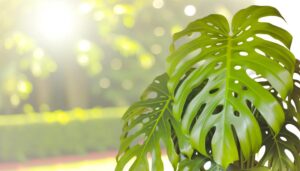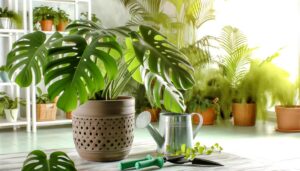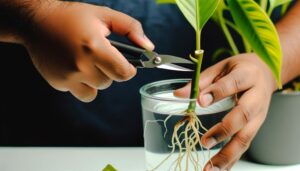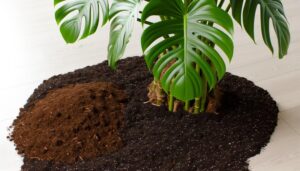Monstera Siltepecana Vs Cebu Blue
To differentiate Monstera Siltepecana from Cebu Blue, note their origins: Siltepecana is native to Southern Mexico and Central America, while Cebu Blue hails from the Philippines. Siltepecana's lance-shaped leaves reach up to 15 inches and feature silver streaks.
Cebu Blue's oval leaves are 4-6 inches, displaying a blue-green hue. Siltepecana climbs to 8-10 feet with thicker stems, whereas Cebu Blue can grow 10-12 feet, with a vigorous vining habit.
Both plants prefer bright, indirect light and must be watered when the top soil layer dries—1 inch for Siltepecana and 2 inches for Cebu Blue. Explore further for more insights.
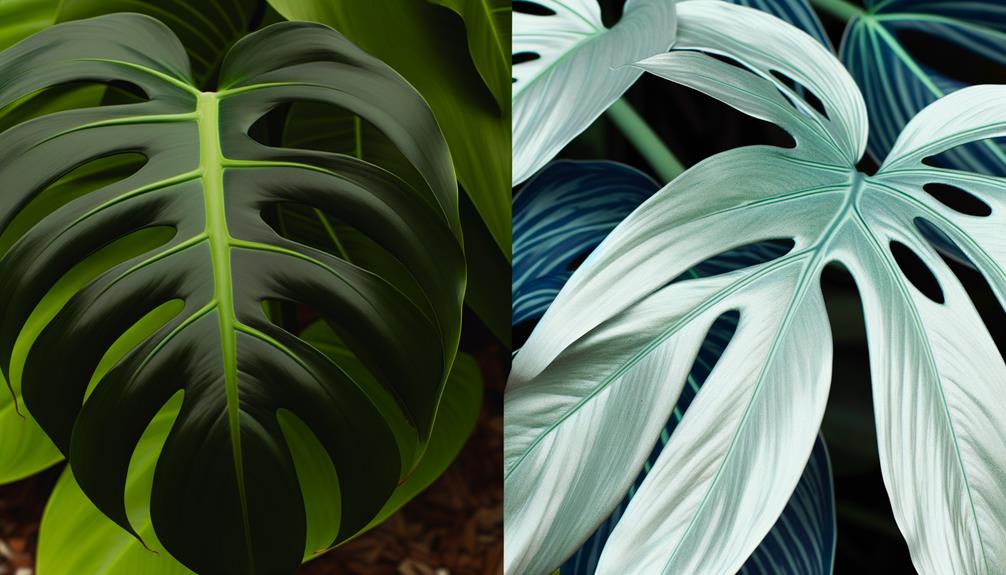
Key Takeaways
- Monstera Siltepecana has lance-shaped leaves with silver streaks, while Cebu Blue has oval-shaped, blue-green shimmering leaves.
- Cebu Blue is a vigorous climber reaching 10-12 feet, whereas Monstera Siltepecana grows more slowly, topping at 8-10 feet.
- Monstera Siltepecana can tolerate lower light levels down to 100 foot-candles, but Cebu Blue needs a minimum of 200 foot-candles.
- Monstera Siltepecana should be watered when the top 1 inch of soil is dry; Cebu Blue requires watering when the top 2 inches are dry.
- Both species need bright, indirect light and proper drainage to prevent root rot and promote healthy growth.
Origin and Background
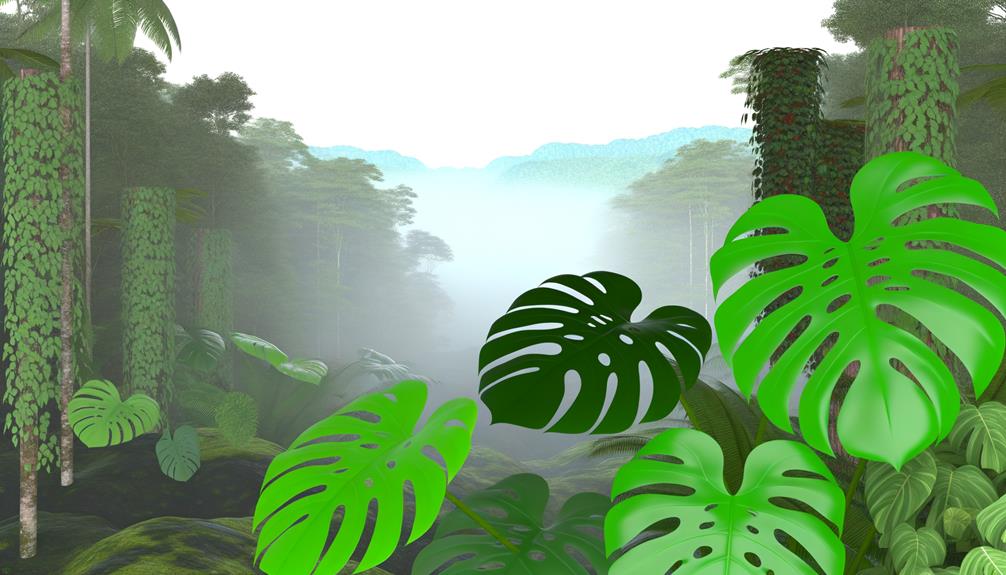
When comparing Monstera siltepecana and Cebu Blue, understanding their origins is pivotal. Monstera siltepecana originates from the lush rainforests of Southern Mexico and Central America. It thrives in humid, low-elevation forests where temperatures range from 18°C to 30°C. You'll observe it clinging to tree trunks, utilizing its aerial roots for support and nutrient absorption.
On the other hand, Cebu Blue, scientifically known as Epipremnum pinnatum 'Cebu Blue,' comes from the tropical regions of the Philippines. It flourishes in the Philippines' tropical climate, characterized by high humidity and temperatures between 20°C and 32°C. In its natural habitat, it often grows as an epiphyte, attaching itself to larger trees and benefiting from filtered sunlight and consistent moisture.
Leaf Shape and Size
Monstera siltepecana features elongated, lance-shaped leaves that can grow up to 15 inches in length, while the Cebu Blue's leaves are typically smaller, reaching about 4 to 6 inches and exhibiting a more oval shape.
You'll notice that Monstera siltepecana leaves also have a distinctive silver streak down the midrib. In contrast, Cebu Blue leaves display a unique blue-green hue with a shimmering effect.
- Monstera siltepecana:
- Leaf length: Up to 15 inches
- Shape: Lance-shaped
- Color: Green with silver streaks
- Cebu Blue:
- Leaf length: 4-6 inches
- Shape: Oval
- Color: Blue-green with shimmer
These differences reflect their unique adaptations and aesthetic appeal, providing varied visual interest in your plant collection.
Growth Patterns
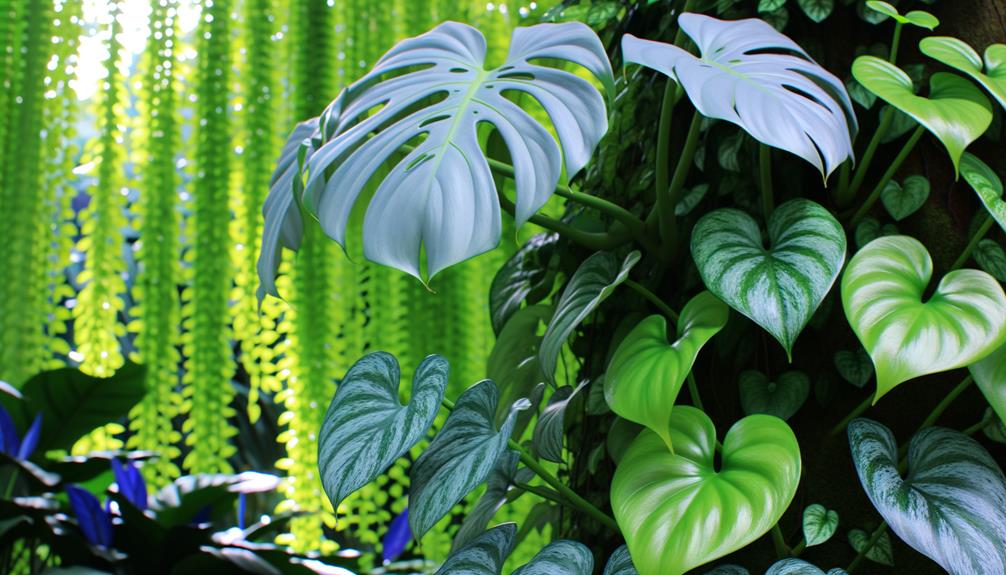
Cebu Blue's growth pattern is characterized by its vigorous vining habit, often reaching lengths of 10 to 12 feet under ideal conditions. You'll notice that it rapidly climbs using aerial roots, making it perfect for vertical spaces. Internodal spacing is typically around 2 to 4 inches, promoting a dense foliage appearance.
In contrast, Monstera Siltepecana exhibits a more controlled climbing habit. It reaches about 8 to 10 feet when mature, with internodes spaced approximately 3 to 5 inches apart. The Siltepecana's growth is slower but forms thicker, sturdier stems, which assist in supporting its weight as it matures.
Both species produce adventitious roots, enhancing their climbing efficiency. Understanding these distinct growth patterns will help you optimize their placement in your space.
Light Requirements
You'll find both Monstera Siltepecana and Cebu Blue thrive in bright, indirect light, but they exhibit different levels of tolerance to low light conditions.
Monstera Siltepecana can endure lower light levels down to 100 foot-candles, whereas Cebu Blue prefers a minimum of 200 foot-candles for best growth.
Observing leaf color and growth rate will help you adjust their positioning to meet these requirements.
Ideal Light Conditions
Both Monstera Siltepecana and Cebu Blue thrive in bright, indirect light, with ideal exposure ranging from 10,000 to 20,000 lumens to promote healthy growth and vibrant foliage. You should aim to provide consistent light conditions to prevent leaf discoloration or stunted growth.
Direct sunlight can cause leaf burn, while insufficient light leads to leggy growth. To achieve best light conditions:
- Place plants near east or north-facing windows.
- Use sheer curtains to filter direct sunlight.
- Supplement with artificial grow lights if natural light is insufficient.
- Rotate plants regularly to ensure uniform light distribution.
- Monitor light levels with a luximeter for precise measurement.
Tolerance to Low Light
Though Monstera Siltepecana and Cebu Blue can tolerate lower light conditions, their growth rates and foliage vibrancy will greatly diminish without sufficient exposure.
Monstera Siltepecana, when exposed to low light, exhibits notably reduced leaf variegation and internodal spacing can increase to 2-3 centimeters.
Cebu Blue, under similar conditions, also shows stunted growth, with leaves often becoming smaller, less fenestrated, and losing their characteristic blue tint.
Both species require at least 100-200 foot-candles of light intensity for best growth. You should place them near a north-facing window or supplement with artificial lighting if natural light is inadequate.
Regularly monitor their light exposure using a light meter to make sure they're receiving enough illumination for sustained health and aesthetic appeal.
Watering Needs
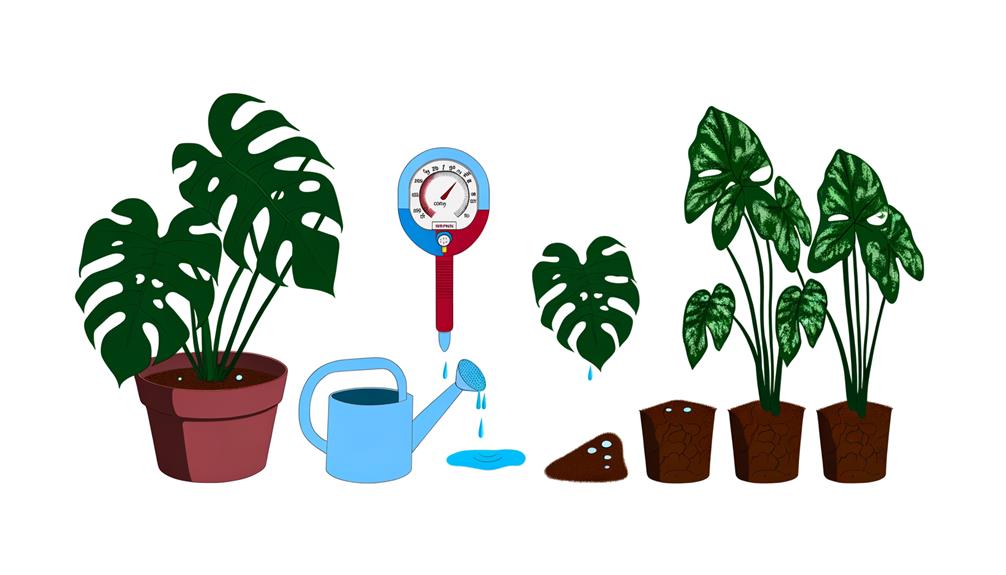
Monstera Siltepecana requires a consistent watering schedule, maintaining the soil's slight moistness without saturating it to prevent root rot. You should water it when the top inch of soil feels dry. Adjust frequency based on seasonal variations and indoor humidity levels. Avoid allowing the plant to sit in standing water, as this can lead to root decay.
Cebu Blue, on the other hand, prefers somewhat drier conditions between waterings. Allow the top 2 inches of soil to dry out before re-watering, and ensure good drainage.
- Water Monstera Siltepecana when the top 1 inch of soil is dry.
- Water Cebu Blue when the top 2 inches of soil are dry.
- Avoid overwatering both species.
- Adjust watering frequency seasonally.
- Guarantee proper drainage to prevent root rot.
Both plants appreciate humidity but differ in their specific watering needs.
Soil and Potting
Selecting the appropriate soil mixture and container for your Monstera Siltepecana and Cebu Blue is crucial for their optimal growth and health. Both species thrive in well-draining, aerated soil. Use a combination consisting of 40% peat moss, 30% perlite, and 30% orchid bark. This mixture guarantees ideal moisture retention and prevents waterlogging.
Select containers with drainage holes to prevent root rot. Monstera Siltepecana prefers slightly acidic soil (pH 5.5-6.5), while Cebu Blue can tolerate a wider pH range (5.5-7.0). Repot every 1-2 years or when roots outgrow the container. Make sure the new container is 2 inches larger in diameter than the previous one to accommodate growth.
Appropriate soil and container practices will promote vigorous, healthy plants.
Common Pests and Diseases
Both Monstera Siltepecana and Cebu Blue frequently face common pests and diseases, requiring careful observation and timely intervention to maintain their health.
You should watch out for:
- Spider mites: Tiny arachnids causing stippling and discoloration. Inspect undersides of leaves with a magnifying glass.
- Mealybugs: White, cotton-like masses often found in leaf axils. Remove using a cotton swab soaked in isopropyl alcohol.
- Scale insects: Hard, brown bumps on stems and leaves. Scrape off gently with a plastic card.
- Root rot: Overwatering leads to brown, mushy roots. Ensure well-draining soil and appropriate watering schedules.
- Powdery mildew: White, powdery fungal growth on leaf surfaces. Improve air circulation and apply fungicides as needed.
Regularly monitoring these issues helps keep your plants healthy and thriving.
Propagation Methods
To propagate Monstera Siltepecana and Cebu Blue, you'll primarily use stem cutting techniques. Cut a 10 cm segment just below a node, ensuring at least one leaf remains.
Then, place the cutting in water, monitoring root development every 7 days until roots reach approximately 5 cm in length.
Stem Cutting Techniques
When propagating Monstera Siltepecana and Cebu Blue, be sure each stem cutting is taken just beneath a node and includes at least one aerial root for optimal growth. Use sterilized pruning shears to make a clean cut, minimizing tissue damage and reducing infection risks.
Make certain the cutting is approximately 4-6 inches long, with at least two leaves intact to sustain photosynthetic activity. Allow the cut end to callous over for 24 hours to prevent rot when placed in the growing medium.
- Node Identification: Locate nodes where roots and leaves emerge.
- Cutting Length: Measure to confirm 4-6 inches.
- Leaf Count: Retain at least two leaves.
- Sterilization: Use rubbing alcohol to sterilize tools.
- Callousing Time: Allow 24 hours.
These steps will greatly improve propagation success.
Rooting in Water
For best outcomes in rooting Monstera Siltepecana and Cebu Blue cuttings in water, make sure each cutting is submerged up to the node where roots will develop. Utilize a see-through container to monitor root growth. Maintain a constant water level, guaranteeing the nodes remain submerged.
Change the water every 5-7 days to prevent bacterial growth. Ideal water temperature should be between 20-25°C (68-77°F). Place the container in indirect sunlight to promote photosynthesis while avoiding leaf burn.
Roots typically emerge within 2-4 weeks. Once roots are 2-3 inches long, transfer the cuttings to soil. Make sure the soil is well-draining to prevent root rot. This method maximizes root development and ensures successful transplantation.
Conclusion
Coincidentally, both Monstera siltepecana and Cebu Blue thrive in similar conditions, making them perfect for your adaptable indoor garden. You'll find their distinctive leaf shapes and sizes, alongside unique growth patterns, enchanting.
By meeting their specific light and watering needs, and ensuring best soil and potting conditions, you're likely to see strong growth. Their propagation methods are simple, but keep an eye out for common pests and diseases.
Your botanical knowledge will surely flourish with these extraordinary plants.

